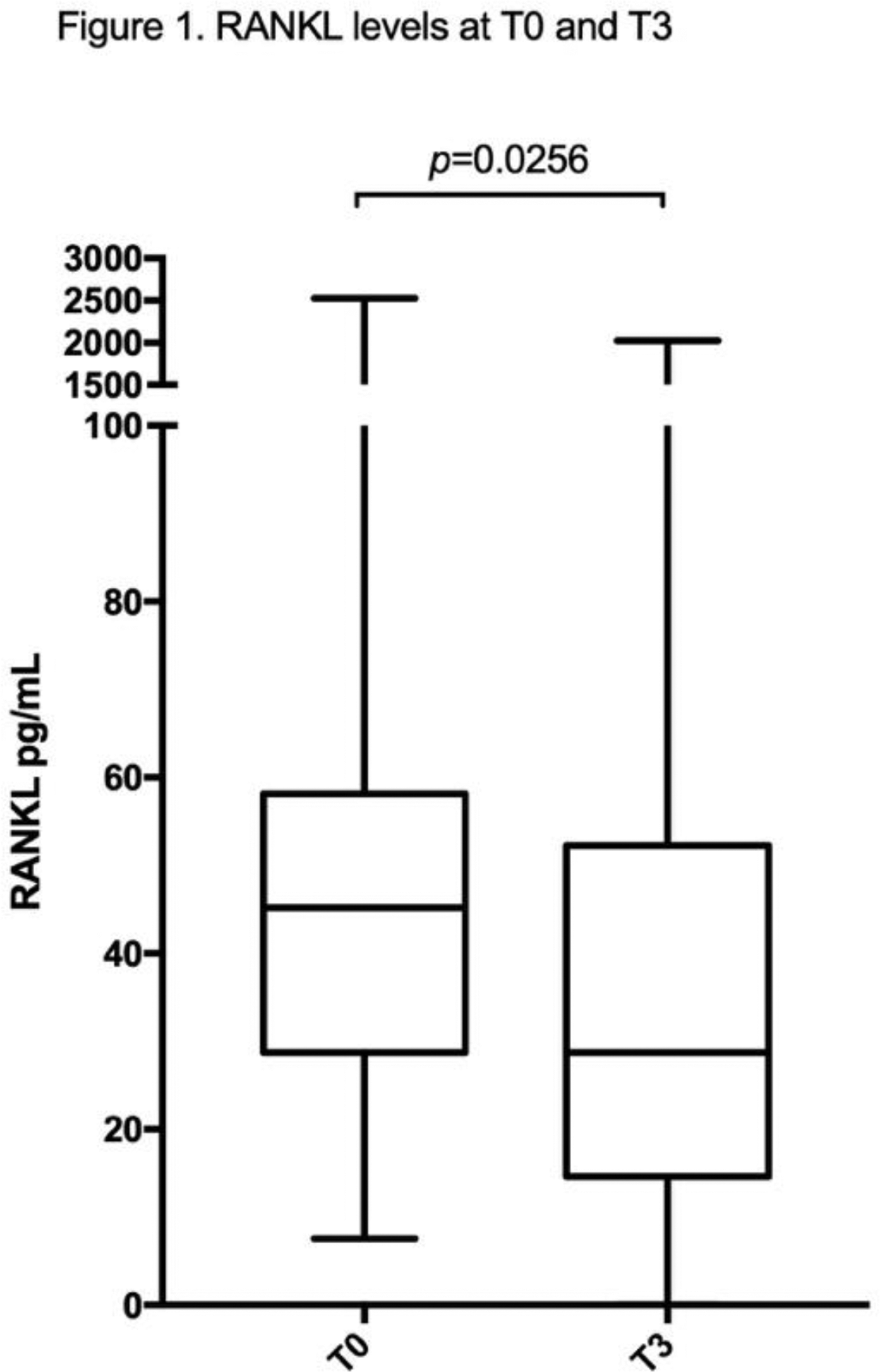

Background: RANKL (receptor activator of nuclear factor κB ligand) and osteoprotegerin, the main regulators of bone metabolism, are involved in osteoblasts/osteoclasts balance in inflammatory disease, such as Rheumatoid Arthritis (RA). Janus kinase (JAK) inhibitors (baricitinib and tofacitinib) can reduce the progression of structural damage in patients with moderate to severe RA. Previous studies suggest a link between JAK inhibition, production of RANKL and osteoclastogenesis 1,2 .
Objectives: to investigate the effect of baricitinib on RANKL serum concentration in unselected RA patients.
Methods: Patients affected by RA according to 2010 ACR criteria, starting treatment with baricitinib as clinically indicated, were consecutively enrolled. Demographic, clinical and laboratory data were collected at baseline (T0) and after three months of therapy (T3). RANKL serum concentration was analyzed by ELISA at the same timepoints. All patients underwent ultrasound (US) examination at T0 and T3. According with OMERACT definitions, the presence of synovial effusion, hypertrophy and power Doppler were assessed and scored on a semi-quantitative scale (0=absent, 1=mild, 2=moderate, 3=severe), obtaining a total US score (0-198), representing the joint inflammatory status (15); erosions were registered. Data were expressed as median (interquartile range); Mann-Whitney and Spearman tests were performed for comparisons and p values < 0.05 were considered statistically significant.
Results: We prospectively followed up 33 RA patients starting treatment with baricitinib [M/F 8/25; age 58(9) years; disease duration 165(150) months; 22/33 (67%) ACPA-anti-citrullinated protein antibody positive; 24/33 patients (73%) RF-rheumatoid factor positive]. After three months of therapy we observed a significant reduction of DAS28
CRP
, CDAI and SDAI compared to baseline (
p
<0.0001). The US inflammatory score showed a significant improvement at T3 (
p
<0.0001). The serum concentration of RANKL showed a significant decrease after three months of therapy from 44 (25.9) to 27.5 (35.3) pg/ml,
p
=0.0256 (
Conclusion: This is the first study demonstrating that baricitinib reduces in vivo the serum levels of RANKL, regardless the correlation with disease activity indices. The discrepancy between the levels of RANKL and the clinical response is in line with previous data in the literature, demonstrating that, under treatment with anti-TNF and anti-IL1, the decrease of RANKL did not influence the local or systemic inflammatory parameters, even if still preventing bone loss 3 .
REFERENCES:
[1]LaBranche T P et al. JAK inhibition with tofacitinib suppresses arthritic joint structural damage through decreased RANKL production. Arthritis Rheum 2012
[2]Murakami, KA Jak1/2 inhibitor, baricitinib, inhibits osteoclastogenesis by suppressing RANKL expression in osteoblasts in vitro. PLOS ONE 2017
[3]Stolina M et al. RANKL inhibition by osteoprotegerin prevents bone loss without affecting local or systemic inflammation parameters in two rat arthritis models: comparison with anti-TNFalpha or anti-IL-1 therapies. Arthritis Res Ther 2009

Disclosure of Interests: Cristina Garufi: None declared, Francesca Romana Spinelli Grant/research support from: Pfizer, Consultant of: Novartis, Gilead, Lilly, Sanofi, Celgene, Speakers bureau: Lilly, Fulvia Ceccarelli: None declared, Silvia Mancuso: None declared, cristiana barbati: None declared, Tania Colasanti: None declared, cristiano alessandri Grant/research support from: Pfizer, Fabrizio Conti Speakers bureau: BMS, Lilly, Abbvie, Pfizer, Sanofi